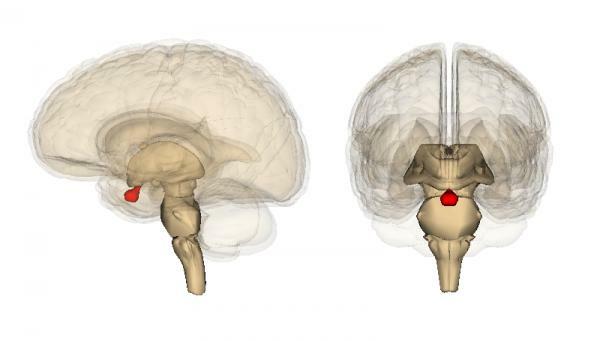
The functioning of the brain and our body does not depend solely on neurons, hormones also play a fundamental role in these processes. The pituitary gland is one that secretes different hormones and regulates a large part of the endocrine activity of our body. The activity of functions as varied as growth, stress reactions or sexual functioning depends on it. If you want to know more about this structure, keep reading this Psychology-Online article: What is the pituitary gland and its function.
Index
- What is the pituitary or pituitary gland
- Pituitary gland: function
- How to stimulate the pituitary gland
- Pituitary gland: diseases
- Pituitary gland: symptoms of malfunction
What is the pituitary or pituitary gland.
The pituitary gland, also called the pituitary gland, is a complex organ that secretes a series of hormones, so it is an endocrine gland.
Where the pituitary gland is located
The location of the pituitary gland is within a bony structure at the base of the brain called
Regarding the anatomy of the pituitary gland, it has an oval shape and is divided into two different parts: anterior lobe or adenohypophysis and posterior lobe o neurohypophysis.
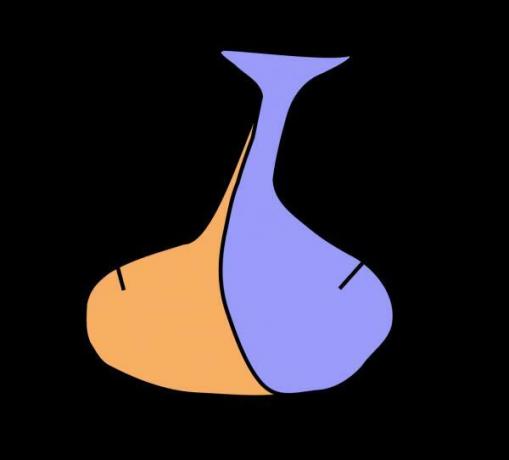
Pituitary gland: function.
In this section we will discuss the pituitary gland and what it is for. The pituitary gland is also called the master gland because it regulates and coordinates the activity of many other endocrine glands that have very diverse functions in the body. Therefore, What is the function of the pituitary gland? Basically the role of the pituitary is considered to be homeostatic, that is, regulates the body to achieve levels of stability, compensation and balance in this. On the one hand, based on the information it receives from the environment through the senses and the thalamus, this gland releases hormones that allow an adaptive response to the demands of the environment. On the other hand, the pituitary gland cyclically secretes hormones vital to the body. Below we list and explain the hormones produced by the pituitary and their role in the functioning and development of human beings:
- Growth hormone or somatropin: stimulates the growth of bones and tissues, as well as favors the formation of muscles and intervenes in the reduction of fat in the tissues. Its function is vital for development during childhood and adolescence, as well as for the maintenance of well-being and health in later ages.
- Thyroid stimulating hormone or thyrotropin: responsible for regulating the activity of the thyroid gland, as well as stimulating the production of hormones by the thyroid.
- Adrenal cortex stimulating hormone or corticotropin: promotes the secretion of cortisol and other hormones by the adrenal glands. Therefore, it has a role in stress responses and metabolism balance.
- Follicle-stimulating and luteinizing hormones: These hormones are called gonadotropins, since they regulate the function of the gonads, that is, the testes and ovaries. In the case of the testicles, it stimulates the production of sperm and in the ovaries that of eggs and other sex hormones.
- Prolactin: favors the production and secretion of milk in the mammary glands, as well as plays a role in sexual function.
- Antidiuretic hormone or vasopressin: It is involved in the body's water balance by regulating the amount of water that the kidneys eliminate in the form of urine.
- Oxytocin: favors the descent of milk in lactation and contractions of the uterus in childbirth.
These last two hormones are produced in the posterior lobe of the pituitary gland and the rest in the anterior lobe.
Pituitary gland: third eye
Due to the role of the pituitary gland in the function of balance and regulation of the organism, from a more mystical perspective it is related to the third eye or energy center of human beings. This third eye is considered to allow true connection and attunement with our inner self and our energy rhythms, as well as harmonizing our energies. In this center reason and emotion would converge, reasoning and intuition.
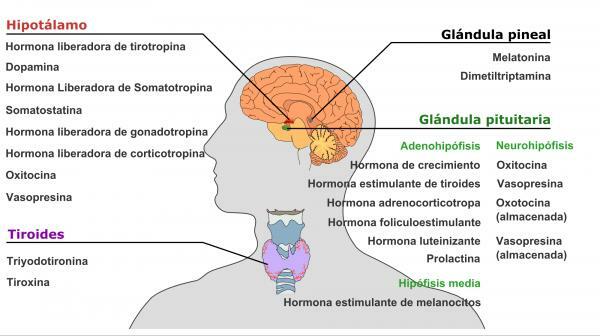
How to stimulate the pituitary gland.
The functioning of the pituitary gland can be improved by adopting and following a healthy lifestyle. The recommendations for its stimulation are the following:
- Practice meditation or mindfulness. Here you will find what is mindfulness and how is it practiced.
- Perform yoga.
- Make exercise assiduously.
- To sleep enough hours and keep a good sleep hygiene.
- Healthy nutrition that includes large amounts of vegetables, legumes, oily fish, eggs and nuts, as well as reducing the levels of foods with sugar and artificial fats.
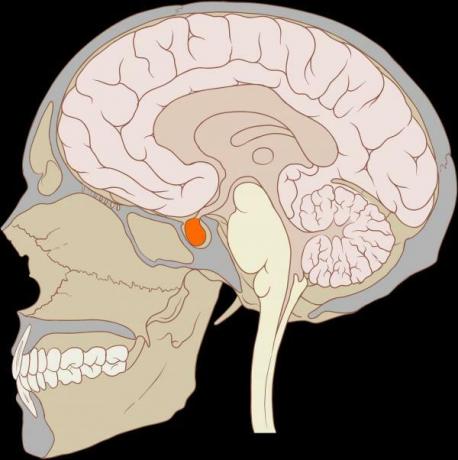
Pituitary gland: diseases.
The alterations of the pituitary gland or pituitary gland They can be produced by an excess or a deficiency of the hormones of this endocrine gland, some of them are the following:
- Acromegaly or gigantism: caused by an excess production of growth hormone, resulting in an increase unusual bone size that results in an increase in size, body dimensions, and height.
- Galactorrhea: its cause is an excess of prolactin, so there is a production of milk in both men and women who are not breastfeeding.
- Diabetes insipidus: Its origin is a low production of vasopressin, which causes an imbalance of fluids in the body that leads to an increase in thirst and the amount of urine.
- Syndrome of inappropriate antidiuretic hormone secretion: it is related to an excess of vasopressin and generates an increase in fluid retention.
- Sheehan syndrome: It is due to the low hormonal secretion by the pituitary gland due to which the pituitary tissue is damaged by severe bleeding during childbirth.
- Pituitary adenoma: they are benign tumors in the cells of this gland that cause an excess of hormonal production.
- Hypopituitarism: refers to the deficit of secretion of some hormone or hormones of the pituitary, the symptoms will depend on those hormones that are affected.
- Cushing's disease: its origin is an excess production of cortisol by adrenal hormones and is characterized by a increase and accumulation of fat in various parts of the body, back pain and stretch marks in the abdominal area, thighs and breasts.
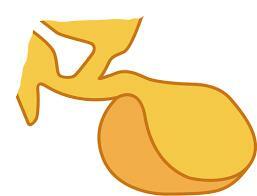
Pituitary gland: symptoms of malfunction.
There are a series of symptoms that can lead to suspicion of the existence of alterations of the pituitary gland. These symptoms in isolation are not indicative of it, and the judgment of a person specialized in medicine is always necessary. Symptoms of a malfunction of the pituitary or pituitary gland are:
- Tiredness, increased cholesterol, and constipation
- Dizziness, hypotension, and altered blood electrolyte values
- Loss of menstruation, infertility, and low sex drive
- Milk secretion
- Increased amount of urine
- Unintentional weight gain or loss
- Fatigue and muscle weakness
This article is merely informative, in Psychology-Online we do not have the power to make a diagnosis or recommend a treatment. We invite you to go to a psychologist to treat your particular case.
If you want to read more articles similar to What is the pituitary gland and its function, we recommend that you enter our category of Neuropsychology.
Bibliography
- Brandan, N. C., Llanos, I., Miño, C. A., Ragazzoli, M. A., & Ruiz Díaz, D. TO. (2011). Hypothalamic and pituitary hormones. National University of the Northeast Faculty of Medicine. Corrientes, Argentine Republic. 25p.
- Fernández-Rodríguez, E., Bernabeu, I., & Casanueva, F. F. (2012). Diseases of the neurohypophysis. Medicine-Accredited Continuing Medical Education Program, 11(13), 782-787.
- Guggiana, M. F., García, M. C., Peynado, E. M. N., & López, A. B. V. (2014). Hypophysis. Anatomy and main tumor pathology.


